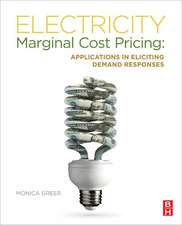Deregulation of Electric Utilities: Topics in Regulatory Economics and Policy, cartea 28
Editat de Georges Zaccouren Limba Engleză Hardback – 30 apr 1998
| Toate formatele și edițiile | Preț | Express |
|---|---|---|
| Paperback (1) | 947.98 lei 43-57 zile | |
| Springer Us – 5 noi 2012 | 947.98 lei 43-57 zile | |
| Hardback (1) | 951.14 lei 43-57 zile | |
| Springer Us – 30 apr 1998 | 951.14 lei 43-57 zile |
Din seria Topics in Regulatory Economics and Policy
- 18%
 Preț: 893.71 lei
Preț: 893.71 lei - 18%
 Preț: 1108.67 lei
Preț: 1108.67 lei - 18%
 Preț: 899.06 lei
Preț: 899.06 lei - 24%
 Preț: 747.51 lei
Preț: 747.51 lei - 18%
 Preț: 1118.75 lei
Preț: 1118.75 lei - 15%
 Preț: 649.87 lei
Preț: 649.87 lei - 18%
 Preț: 1117.03 lei
Preț: 1117.03 lei - 15%
 Preț: 593.08 lei
Preț: 593.08 lei - 18%
 Preț: 789.98 lei
Preț: 789.98 lei - 18%
 Preț: 1233.20 lei
Preț: 1233.20 lei - 18%
 Preț: 944.99 lei
Preț: 944.99 lei - 15%
 Preț: 640.71 lei
Preț: 640.71 lei - 18%
 Preț: 953.35 lei
Preț: 953.35 lei - 18%
 Preț: 953.35 lei
Preț: 953.35 lei - 18%
 Preț: 954.45 lei
Preț: 954.45 lei -
 Preț: 385.47 lei
Preț: 385.47 lei - 15%
 Preț: 647.27 lei
Preț: 647.27 lei - 15%
 Preț: 639.90 lei
Preț: 639.90 lei - 15%
 Preț: 643.34 lei
Preț: 643.34 lei - 18%
 Preț: 951.14 lei
Preț: 951.14 lei - 18%
 Preț: 948.47 lei
Preț: 948.47 lei - 15%
 Preț: 646.11 lei
Preț: 646.11 lei - 18%
 Preț: 1487.96 lei
Preț: 1487.96 lei - 15%
 Preț: 640.71 lei
Preț: 640.71 lei - 18%
 Preț: 950.03 lei
Preț: 950.03 lei - 15%
 Preț: 643.34 lei
Preț: 643.34 lei - 15%
 Preț: 647.40 lei
Preț: 647.40 lei
Preț: 951.14 lei
Preț vechi: 1159.94 lei
-18% Nou
Puncte Express: 1427
Preț estimativ în valută:
181.100€ • 190.53$ • 150.59£
181.100€ • 190.53$ • 150.59£
Carte tipărită la comandă
Livrare economică 07-21 aprilie
Preluare comenzi: 021 569.72.76
Specificații
ISBN-13: 9780792381341
ISBN-10: 0792381343
Pagini: 342
Ilustrații: XIX, 342 p.
Dimensiuni: 155 x 235 x 29 mm
Greutate: 0.61 kg
Ediția:1998
Editura: Springer Us
Colecția Springer
Seria Topics in Regulatory Economics and Policy
Locul publicării:New York, NY, United States
ISBN-10: 0792381343
Pagini: 342
Ilustrații: XIX, 342 p.
Dimensiuni: 155 x 235 x 29 mm
Greutate: 0.61 kg
Ediția:1998
Editura: Springer Us
Colecția Springer
Seria Topics in Regulatory Economics and Policy
Locul publicării:New York, NY, United States
Public țintă
ResearchCuprins
1 IPPs get VAMMoed in Texas.- 1.1 Introduction.- 1.2 Background.- 1.3 Transmission Tariffs.- 1.4 The ERCOT Transmission Tariff.- 1.5 Conclusion.- References.- 2 Competition and Direct Access in New Zealand’s Electricity Market.- 2.1 Introduction.- 2.2 A Simple Model for the Electricity Market.- 2.3 The Electricity Distribution Market.- 2.4 Some Preliminary Econometric Results.- 2.5 Conclusions.- References.- 3 Competition and Access in Electricity Markets: ECPR, Global Price Cap, and Auctions.- 3.1 Introduction.- 3.2 Basic Principles and Fundamental Issues.- 3.3 Access Pricing Rules.- 3.4 Price Caps and Global Price Caps.- 3.5 Market Based Regulation or Managed Competition.- 3.6 Conclusion: Some Neglected Issues.- References.- 4 Periodic Regulatory Review in UK Electricity Markets; Developments Within a Deregulated System.- 4.1 Introduction.- 4.2 The Structure of the Price Controls in Electricity.- 4.3 Yardstick Comparisons.- 4.4 The Choice of X Factor.- 4.5 Regulation in Practice.- 4.6 The RECs’ Productivity 1971–96.- 4.7 Privatised Utility Profits in the RECs.- 4.8 Competitive Supply, Access, and Settlement.- 4.9 The Debate on Regulatory Mechanisms.- References.- 5 Challenges for Effective Competition in Large-Hydro Dominated Markets: The Case of Québec.- 5.1 Introduction.- 5.2 Obstacles to Competition.- 5.3 Standard Solutions.- 5.4 A Made-in-Québec Solution: The LGMC Contract.- 5.5 Other Obstacles and Imperatives to Competition.- 5.6 Other Considerations.- 5.7 Conclusion.- References.- 6 Hydroelectricity and the State in Quebec and Ontario: Two Different Historical Paths.- 6.1 Introduction.- 6.2 A Historical Survey of Electricity Regulatory Regimes in Canada.- 6.3 The Different Paths of Regulation in Central Canada: A Political Economy Approach.- 6.4Conclusion.- References.- 7 Restructuring and Competitive Arrangements in the Electricity Supply Industry Towards a Better Efficiency?.- 7.1 Introduction.- 7.2 The Incompatibility of Vertical Integration and Competition in the Supply: The Unsound Route of Third Party Access to the Network.- 7.3 Competitive De-integration through the Interlocking of Complex Arrangements.- 7.4 An Appraisal of Competitive De-integration.- 7.5 Conclusion.- References.- 8 Electricity Deregulation in England and Wales.- 8.1 Introduction.- 8.2 Competition in Generation.- 8.3 Competition in Supply.- 8.4 The Natural Monopolies.- 8.5 The Overall Effect of the Reforms.- 8.6 Conclusions.- References.- 9 Improving the Performance of Electricity Industries in Developing Countries: Is World Bank Policy on Deregulation the Way Forward?.- 9.1 Introduction.- 9.2 International Policy Towards Power Sector Development.- 9.3 Some Models to Follow.- 9.4 Performance and Efficiency Measurement.- 9.5 The Data.- 9.6 The Efficiency of Developing Countries’ Power Generation.- 9.7 Which Example to Follow?.- 9.8 Lending to Sub Saharan Africa (SSA).- 9.9 An Alternative Approach Using DEA Results.- 9.10 Conclusions and Limitations of the Analysis.- References.- Appendix: 1. Efficiencies of Power Sectors in Developing Countries.- Appendix: 2.- 10 Demand-Side Management Expenditures and the Market Value of U.S. Electric Utilities: Strategic Investment or Disinvestment?.- 10.1 Introduction.- 10.2 Previous Studies of Market Value/ Performance of Electric Utilities.- 10.3 “Radical” Deregulation of the U.S. Electric Power Market.- 10.4 Methodology.- 10.5 Empirical Estimation of Utility Market Value.- 10.6 DSM’s Role: Strategic Disinvestment by Utilities?.- 10.7 Summary.- References.- 11 Introducing Competition tothe Electricity Industry in Spain: The Role of Initial Conditions.- 11.1 Introduction.- 11.2 The MLE and the Definition of Stranded Costs.- 11.3 Vertical Relations in the Domestic Coal Industry.- 11.4 Industry Structure.- 11.5 Prospects for Competition.- 11.6 Conclusion.- References.- 12 Peak Load Problem, Deregulation and Reliability Pricing.- 12.1 Introduction.- 12.2 Peak Load Problem and Reliability Problem.- 12.3 Peak Load Reduction Mechanisms in a Deregulated Environment.- 12.4 Reliability Pricing Propositions.- 12.5 Research Avenues.- References.- 13 An Integrated Energy and Reserve Market for New Zealand.- 13.1 Introduction.- 13.2 Principles of a Reserve Market.- 13.3 Modelling Instantaneous Reserve.- 13.4 Experience.- References.- 14 Transmission Contracts May also Hinder Detrimental Network Investments in Oligopolistic Electricity Markets.- 14.1 Introduction.- 14.2 A Three Node Example with Market Power.- 14.3 Some Reinterpretation.- 14.4 The Conjecture.- 14.5 Conclusion.- References.- Appendix: 1.- Appendix: 2.














